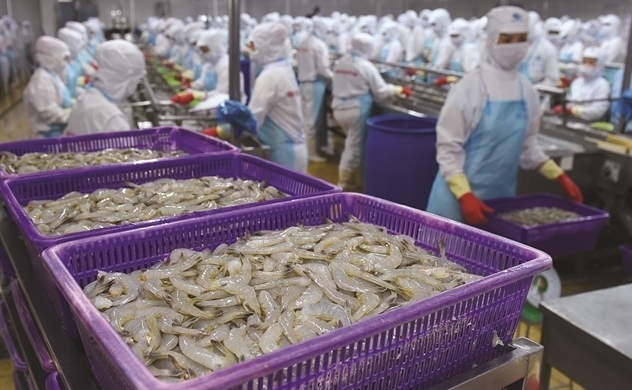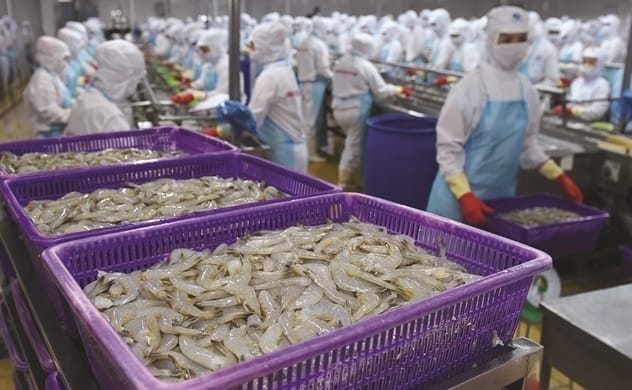
Despite achieving record export results last year, this year the shrimp industry is forecast to face many difficulties due to market fluctuations. Photo: TL
Minh Phu Seafood Corporation earned the title “King of Shrimps” in 2003 when the demand for seafood was at an all-time high. In its heyday, Minh Phu was among the industry’s top three, but the company’s revenue has since fallen, and it must now find a method to compete against new rivals.
Double burden
Minh Phu had an unexpected first-half business performance in 2022 with a loss of approximately VND100 billion two years after the pandemic. It was the first loss in seven years. Revenue and after-tax profit are expected to drop 22% this year, while the company expects $541 million in export turnover, down 30%.
Despite record exports in 2022, market changes are expected to hurt the shrimp business. Shrimp production cost is too expensive, another subjective reason. Minh Phu’s business troubles are framed within the industry’s overall issues.
In 2021, approximately 800 Vietnamese firms exported seafood, according to VASEP. The Top 100 firms with $20-400 million in revenue account for 65% of the country’s seafood export. Minh Phu led fish and shrimp exports in Vietnam with sales of nearly $395 million, accounting for 4.44%.
“High cost of farming makes it difficult for Vietnamese shrimp to compete with rival countries such as Ecuador and India”, said Mr. Le Van Quang, Chairman of Minh Phu Seafood Company. He added Ecuador, India, and Vietnam’s raw shrimp production costs for 50-60 shrimp per kilogram are $2.3-2.4, $3.4-3.8, and $4.8-5, respectively. The main cause is the low success rate. Minh Phu and other industry businesses can’t sell because of this.
Currently, the success rate of shrimp farming in Vietnam is on average less than 40%, much lower than in Ecuador, which is over 90%, and in India over 60%. The price of raw shrimp in Vietnam is twice as high as that of Ecuador.
Against this backdrop, China has increased its purchases of shrimp from other countries while reducing orders for shrimp products from Vietnam. Specifically, China’s shrimp imports in the first quarter of 2023 from Ecuador increased by 43%; from India by 16%; from Argentina increased 205% over the same period last year. Meanwhile, the US market is also falling sharply.
Price race
Faced with pressure on selling prices in the market, Minh Phu said that only 10% of raw materials were self-sufficient, and 90% were bought from outside at the same price as the company’s own shrimp and farming association. But since April, the Company has had to reduce the price of shrimp from outside to be able to have a good price to compete with Indian and Ecuadorian shrimp.
The company is also planning a new plan with a key strategy that by 2030 the price of Vietnamese raw shrimp will be equal to that of India and strives to have the price of Vietnamese raw shrimp equal to Ecuador by 2035.
To do that, Minh Phu offers a strategy of not directly competing with Ecuador’s too-low prices, so it has to increase the production and export of black tiger shrimp, white-leg shrimp, and land shrimp.
According to statistics of VASEP, in the first half of this year, Vietnam’s seafood exports reached about $3.5 billion, down nearly 30% compared to the same period last year. The competitive pressure between Vietnamese shrimp and India and Ecuador is increasing when these two countries are actively participating in the value-added shrimp export segment.
Last year, when meat shrimp exports to the US decreased, Indian shrimp exporters made efforts to invest in new factories and steaming lines to increase the export volume of steamed shrimp products this year.
Imports of US steamed shrimp products increased by 6% to 142,958 tons, of which India’s exports increased by 36% to 56,854 tons, accounting for 39% of the market share. After the epidemic, Indian shrimp companies also focused on boosting value-added production to improve their competitive advantage over Ecuadorian and Vietnamese producers to regain market share in the US.
Truong Dinh Hoe, General Secretary of VASEP, said: “This year’s export turnover is only estimated at $9-10 billion, down $1-2 billion compared to 2022.” According to the Import-Export Department (Ministry of Industry and Trade), from the third quarter of 2023 onwards, seafood exports to this market will slow down.
Despite the current difficulties, the head of Minh Phu is still optimistic when it is expected that from August 2023 onwards, shrimp prices will increase, the inventory will be resolved, and the business situation of the Company will be better. Specifically, according to Mr. Quang, due to the low price of shrimp in the market, the situation of “hanging ponds” in India is 30-50%. And in Ecuador, with a lot of rain, shrimp die up to 30%. This causes shrimp production at the end of this year to drop sharply and prices will increase.
In Vietnam, low shrimp prices also cause many farmers to “hang up the pond” up to 30-50%. Accordingly, shrimp production will also decrease by 30-50%. The lack of supply will help “push” inventories to the market by the end of this year because there are many festivals at the end of the year, causing consumption to increase, then shrimp prices will increase again.





